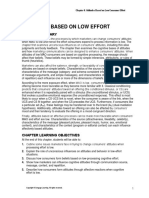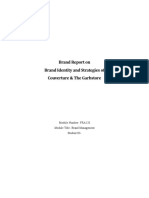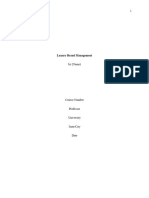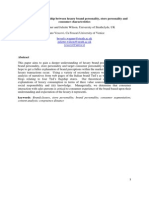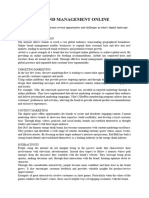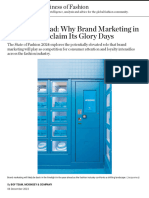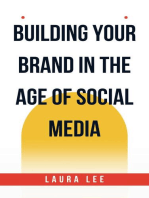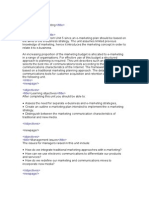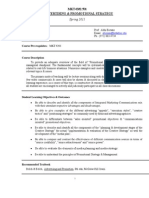Masters Report Marketing
Masters Report Marketing
Uploaded by
Lee HSCopyright:
Available Formats
Masters Report Marketing
Masters Report Marketing
Uploaded by
Lee HSOriginal Title
Copyright
Available Formats
Share this document
Did you find this document useful?
Is this content inappropriate?
Copyright:
Available Formats
Masters Report Marketing
Masters Report Marketing
Uploaded by
Lee HSCopyright:
Available Formats
Compare and contrast the stores of two luxury brands, Burberry and Prada
Introduction
The utility of brand identity in modern enterprise is quickly evolving beyond the push-based
advertising agenda of a fragmented and geographically distributed brand (Delgado-Ballester and
Munuera-Aleman, 2005). As marketers identify and employ compelling messages in the
ys
definition and architecture of their brand identity, consumers are challenged to assess, interpret,
and engage with these innovative characteristics (Loureiro et al., 2014). For luxury fashion
sa
retailers, the brand identity is a composite of both the marketing enterprise and the retail
experience, aligning consumer perceptions with a robust and transparent spectrum of identifying
Es
characteristics that unify the brand message and identity (Gentile et al., 2007). In an effort to
differentiate in the highly competitive luxury marketplace, retailers are increasingly relying upon
a range of aesthetic and identity-specific characteristics within their retail outlets to manifest a
ge
unique and compelling experience (Maxwell, 2016). The following sections will compare and
contrast the retail outlet strategies of two market leading luxury brands, Burberry and Prada, in
order to identify particular traits and characteristics that are conducive to competitive advantage
rid
and demand-enhancing outcomes.
xb
Market Position
The form, function, and identity of the luxury store represents the ‘locus’ of an organisational
focus, unifying the perspectives of stakeholders within a singular establishment that transcends
O
the multi-channel marketing strategy of a given brand (Doyle et al., 2008, p. 553). Whilst many
retailers in the fashion industry have adopted more generic retail standards, Moore et al. (2010)
,J
contest that the luxury retailer is differentiated by the strength, heritage, and reputation of their
brand. From quality to pricing and exclusivity, the luxury agenda is driven by a brand DNA that
C1
is based on prestige, image, and superiority in an industry in which luxury fashion is increasingly
commodified and generalised (Moore et al., 2010). For brands like Prada, for example, King
(2014) observes a relationally-centred marketing message that is based upon surprise and
elegance, instilling continuity and high status messages in each consumer exchange. With a
heritage steeped in luxury fashion, Burberry leverages more than 160 years of status and fashion
Oxbridge Essays www.oxbridgeessays.com
innovation to draw distinction between its brand and other competitors, legitimising its luxury
status through historic justification of its quality and market position (Burberry, 2016)
.
The distinction between status and quality in the luxury fashion market is of critical importance
to companies like Burberry and Prada who are objectifying their products within the context of
consumer-specific marketing campaigns. ‘High involvement shopping’, an experiential process
ys
described by Wu et al. (2015, p. 299) relies upon the development of an identity-based alliance
between the consumer and the brand. Celebrity status, for example, at Prada has created an
sa
alliance between the brand and a new generation of millennial consumers as reputation and elitist
characteristics drive new styles and demand perspectives (Dacre, 2016). This form of transition,
Es
however, is challenging, as Prada has remained an ‘icon of global wealth’ for generations by
producing consistent, predictable, and legacy styles for affluent, typically older consumers
(Halzack, 2015, p. 1). Transitioning its brand DNA towards a more dynamic representation of
ge
identity and value ultimately requires an alliance between the marketing communications
channels and the retail establishment, whereby in-store replication of iconic models from recent
fashion shows or Prada-sponsored events are compelling new consumer interest (Carreon, 2011;
rid
Dacre, 2016).
xb
At the foundation of the modern Burberry brand is a commitment to digital enterprise, whereby
targeting and positioning initiatives were based upon consumer expectations and values amongst
specific populations (Swire, 2014). By focusing on youthful, born-digital consumers and
O
modernising both the on and offline store experiences, Burberry has emphasised a paradigm of
individuality, whereby distinctive fashions overshadow mass production and commodification
(Swire, 2014). As Burberry has committed to an individualised experience, Doyle et al. (2008)
,J
challenge that in order to differentiate from other luxury retailers and store experiences, there
C1
must be an active investment in consumer-centred service throughout the full scope of the
shopping process. From the lighting and store aesthetics to the service providers and in-store
communication, it is this transcendence of individuality that allows Burberry to attract luxury
fashion consumers and retain their interest in spite of limited stock and selective clothing styles.
Predicated upon what Nobbs et al. (2012, p. 925) characterise as a ‘strategic purpose’, it is this
Oxbridge Essays www.oxbridgeessays.com
continuity between Burberry’s marketing messages and its in-store aesthetic that serves as a
conduit or unifying representation of brand ‘artefacts’ and heritage values in physical form.
Brand Messaging
Underscoring the core characteristics of an effective brand messaging campaign are a
commitment to image-specific factors that influence brand identity and consumer perceptions of
ys
the brand’s values, personality, and identifying characteristics (Oliveira-Castro et al., 2008).
Burberry, for example, has created a model for seamless integration between on and offline
sa
shopping catalogues, by replicating the digital experience within its flagship retail outlet on
London’s Regent Street (Caroline, 2014). The strategy is based upon the realisation of
Es
continuity throughout the brand’s marketing presence, ensuring that on and offline experiences
are complementary and consistent (Caroline, 2014). Driven by in-store technology that
complements the on-the-rack aesthetics of the Burberry product, consumers are presented with
ge
images and lighting characteristics that complement the online browsing experience,
transcending the gap between physical and virtual in order to enhance consumer experience and
self-identification (Patel, 2013). Ultimately, such efforts mirror the 2004 missteps (non-
rid
functioning or inconsistent technology) of Prada to introduce experimental shopping experiences
using RFID tags and in-store digitisation of fashion trends (Linday, 2004). Specifically, the
xb
integration of RFID tags into clothing at Burberry retail outlets creates interactive environments
in which consumers select clothing items and then manipulate their own environment on the
basis of these selections, personalising the shopping process and aligning self-identification with
O
the images and personas displayed throughout the retail screens and brand message (Patel, 2013).
Within the luxury retail format, Manlow and Nobbs (2013) observe several trends that
transcend brand-specific environments including an emphasis on marketing communications, a
,J
relational and individual focus, and an enterprise agenda (e.g. sales, product access, location-
C1
specific advantages). For this reason, site-specific and in-store characteristics affect the
reputational capital of a given retailer, potentially enhancing or diluting the brand message in
accordance with consumer perspectives and symbolic representations of the store identity
(Manlow and Nobbs, 2013). In fact, evidence from an international survey of luxury fashion
retailers by Arrigo (2015) revealed that location-specific forces have significant identification
Oxbridge Essays www.oxbridgeessays.com
implications for brand messaging and consumer perceptions of brand quality, reputation, and
status. For this reason, generic storefronts and commodified retail establishments have the
potential to dilute brand value and consumer perspectives, leading to a conflict of messaging and
identity as companies strive to diversify their market position (Arrigo, 2015). Burberry, in direct
contrast to such diversification strategies, has narrowed not only its in-store selection, but its
store position throughout the global marketplace in order to create a dimension of exclusivity
ys
that limits consumer access and enhances the experiential tenets of in-store shopping.
Whilst Prada has failed to achieve the location-based exclusivity of the Burberry retail
sa
establishments, the company has utilised its in-store marketing and aesthetics to manifest
conditions of exclusivity and consumer-centred experiences. Citing an open-format, low-
Es
marketing presence, Fiore (2010) observes a London-based Prada flagship store with low
product per square metre features, a prestige-based pricing strategy, a non-descript storefront,
and selective in-store vignettes. The low density strategy is designed to construct a sense of
ge
individuality and personalisation within a retail enterprise that is typified by volume-based sales
and crowded consumer environments (Fiore, 2010). By actively minimising the number of
displays, number of products, and number of styles, Prada prioritises iconic fashion and
rid
exploratory, rather than reactive or tactical consumer behaviour. It is this form of selective
interaction between the brand and the consumer that typifies the Prada brand identity and
xb
escalates a high-cost fashion icon to an in-demand market leader in both on and offline retail
consumerism (RDB, 2015).
O
Contrast Between Brands
In order to target specific consumer populations, Burberry has utilised its in-store culture and
service experiences to reflect its ideal position for a youthful, discerning, and custom-centred
,J
consumer (Swire, 2014). Sales outcomes include significant retail growth as consumers link the
C1
on and offline experiences, pursuing distinctive styles that are individualised via online channels
and then customised and sampled at the store level (Swire, 2014). Prada, alternatively, has relied
heavily upon reputational capital that is being driven by celebrity engagement, market status, and
international positioning as the brand continues to expand its identity and presence throughout
both traditional (e.g. older, affluent, experienced) and emergent (e.g. millennial, new money,
Oxbridge Essays www.oxbridgeessays.com
individual) markets (Halzack, 2015). Within the Burberry store, the lack of product is as
important as the access to particular styles and in-the-moment displays, creating access hurdles
for discerning consumers that recognise the advantages of selective and personalised shopping
experiences. For Prada, iconic aesthetics ranging from a black and white checked floor to stark
white walls and simplified displays are indicative of selective offerings and in-demand products
at a luxury-store premium price (Carreon, 2011; RDB, 2015). However, whereas Burberry is
ys
driven by an innovative concept of worn-by-design, Prada has adopted a designed-for-sale
approach, creating a stark differentiation in the nature of the in-store consumer experience and
sa
the underlying strategies being employed at each of these luxury retailers.
Es
The strategic representation of individuality within the Burberry retail strategy achieves what
Moore et al. (2010) have identified as a critical bridge between consumer expectations and
distinctive brand characteristics and features, eliminating commodity characteristics in favour of
ge
selective, personalised experiences. It is this formal exclusivity that allows luxury retail
establishments to characterise the core values and root agenda of the brand, selectively
representing the best features and strengths of the brand without the noise and interference of
rid
outside environments (Nobbs et al., 2012). In contrast, however, Prada has relied heavily upon
its exclusivity and identity within the global community to present a very opulent and indulgent
xb
brand image, but to create a form of arm’s-length gap between the consumer and the product.
Elevated in-store shelving, for example, is used to position purses and handbags out of consumer
reach, manifesting an artistic, on-display aesthetic, but limiting consumer access and compelling
O
employee-consumer interactions. Burberry, alternatively, utilises images of target consumers to
represent its brand identity and highlight its accessibility to a broad, diverse, and individualistic
population of consumers within its retail stores. This distinction ultimately reflects a broader
,J
reputational fissure between these two companies, and as a result, creates competitive variations
C1
that are likely to affect long term growth and sales potential.
Recommendations
Each of these retailers has developed a robust reputation and identity based upon the exclusivity
of luxury fashion retailing. However, whilst Prada has traditionally marketed to older, more
Oxbridge Essays www.oxbridgeessays.com
affluent, urban consumers, Burberry has developed an in and out of store campaign to attract
younger, fashion-savvy consumers with an individualised spirit and agenda. The selectivity of
in-store stock, for example, compels Burberry shoppers to actively engage in the shopping
process or risk lost styles and bespoke products that are likely to be consumed by other
individuals. Prada has offered equally exclusive product lines; however, elects to architect its
identity and characteristics on the basis of celebrity status and identity, a strategy that may
ys
ultimately dilute the individualisation of the products and accessories. From a store-based
perspective, each of these retailers has been extremely successful; however, there are particular
sa
characteristics observed in this analysis that can be utilised more effectively in order to stimulate
sales and enhance the brand-consumer alliance throughout the multi-channel shopping
Es
experience:
Recommendation 1: Experiential Retailing Must be Consumer-Driven: The retailing
ge
experience is personal; and therefore, it cannot be commodified. Consumers must
actively engage in their own experiential outcomes by selecting in-store resources (e.g.
digital connections, personalisation stations, store divisions) that are attractive and
rid
compelling. This involves environments that encourage individuality and self-
customisation of the shopping experience.
xb
Recommendation 2: Environmental Features Should be Identity-Forming: The
brand-consumer alliance is conditioned by the brand identity and its intersection with
O
consumer values and self-identification. Therefore, any luxury fashion retailing
experience should be identity-forming within the context of this unified perspective.
Consumers should immerse themselves within the brand through interactive, value-
,J
specific experiences within the retail environment.
C1
Oxbridge Essays www.oxbridgeessays.com
References
Arrigo, E. (2015) ‘The Role of the Flagship Store Location in Luxury Branding: An International
Exploratory Study.’ International Journal of Retail and Distribution Management, 43(6), pp.
518-537.
Burberry. (2016) ‘About Us.’ Burberry, Available At: https://us.burberry.com/our-history/.
ys
[Accessed 20 September, 2016].
Caroline, T. (2014) ‘Leading Luxury Brands Merging Digital and Physical Spheres Through
sa
Innovative Retail Store Designs.’ The Future of Luxury, 18 August, Available At:
http://www.thefutureofluxury.co.uk/retail-store-design/. [Accessed 20 September, 2016].
Es
Carreon, B. (2011) ‘China’s Super Rich Go Gaga over Prada.’ Forbes, 27 May, Available At:
http://www.forbes.com/sites/bluecarreon/2011/05/27/chinas-super-rich-go-gaga-over-
ge
prada/#6cc6b3d52468. [Accessed 20 September, 2016].
Dacre, K. (2016) ‘Miucci Prada Connects with Her Millennial Customers.’ Evening Standard, 10
rid
March, Available At: http://www.standard.co.uk/fashion/news/miuccia-prada-connects-with-her-
millennial-customers-as-celebrity-models-kendall-jenner-gigi-hadid-a3199971.html. [Accessed
20 September, 2016].
xb
Delgado-Ballester, Munuera-Aleman, J.L. (2005) ‘Does Brand Trust Matter to Brand Equity?’
Journal of Product and Brand Management, 14(3), pp. 187-196.
O
Doyle, S.A., Moore, C.M., Doherty, A.M., Hamilton, M. (2008) ‘Brand Context and Control:
The Role of the Flagship Store in B&B Italia.’ International Journal of Retail and Distribution
,J
Management, 36(7), pp. 551-563.
C1
Fiore, A.M. (2010) Understanding Aesthetics for the Merchandising and Design Professional.
New York: Fairchild.
Oxbridge Essays www.oxbridgeessays.com
Gentile, C., Spiller, N., Noci, G. (2007) ‘How to Sustain the Customer Experience: An Overview
of Experience Components that Co-Create Value With the Customer.’ European Management
Journal, 25(5), pp. 395-410.
Halzack, S. (2015) ‘Why Louis Vuitton, Gucci, and Prada are in Trouble.’ The Washington Post,
15 June, Available At: https://www.washingtonpost.com/business/economy/louis-vuitton-and-
guccis-nightmares-come-true-wealthy-shoppers-dont-want-flashy-logos-
ys
anymore/2015/06/15/e521733c-fd97-11e4-833c-a2de05b6b2a4_story.html. [Accessed 20
September, 2016].
sa
King, J. (2014) ‘Prada Tells Creation Story of Candy Florale Fragrance with Comic Book.’
Es
Luxury Daily, 10 June, Available At: https://www.luxurydaily.com/prada-tells-creation-story-of-
candy-florale-fragrance-with-comic-book/. [Accessed 20 September, 2016].
Lindsay, G. (2004) ‘Prada’s High-Tech Misstep.’ CNN Money, 1 March, Available At:
ge
http://money.cnn.com/magazines/business2/business2_archive/2004/03/01/363574/. [Accessed
20 September, 2016].
rid
Loureiro, S.M.C., Lopes, R.., Kaufmann, R. (2014) ‘How Brand Personality, Brand
Identification and Service Quality Influence Service Brand Equity.’ Cogent Business and
xb
Management, 1, pp. 1-12.
Manlow, V., Nobbs, K. (2013) ‘Form and Function of Luxury Flagships.’ Journal of Fashion
O
Marketing and Management, 17(1), pp. 49-64.
Maxwell, S. (2016) ‘The Future of Retail Innovation: A Question of Space?’ Pearlfisher,
,J
Available At: http://www.pearlfisher.com/live/perspectives/the-future-of-retail-innovation-a-
question-of-space/. [Accessed 20 September, 2016].
C1
Moore, C.M., Doherty, A.M., Doyle, S.A. (2010) ‘Flagship Stores as a Market Entry Method:
The Perspective of Luxury Fashion Retailing.’ European Journal of Marketing, 44(1/2), pp. 139-
161.
Oxbridge Essays www.oxbridgeessays.com
Nobbs, K., Moore, C.M., Sheridan, M. (2012) ‘The Flagship Format Within the Luxury Fashion
Market.’ International Journal of Retail and Distribution Management, 40(12), pp. 920-934.
Oliveira-Castro, J.M., Foxall, G.R., James, V.K., Pohl, R.H.B.F., Dias, M.B., Chang, S.W.
(2008) ‘Consumer-Based Brand Equity and Brand Performance.’ The Service Industries Journal,
28(4), pp. 445-461.
ys
Patel, D. (2013) ‘Luxury Retailers Leading the Way with In-Store Technology.’ The Guardian,
15 January, Available At: https://www.theguardian.com/media-network/media-network-
sa
blog/2013/jan/15/luxury-retailers-in-store-tech. [Accessed 20 September, 2016].
RDB. (2015) ‘Prada Store by Roberto Baciocchi’. Retail Design Blog, Available At:
Es
http://retaildesignblog.net/2015/04/13/prada-store-by-roberto-baciocchi-st-petersburg-russia/.
[Accessed 20 September, 2016].
ge
Swire, R. (2014) ‘Why is Burberry’s Digital Strategy so Good?’ Parallax, Available At:
https://parall.ax/blog/view/3047/why-is-burberry-s-digital-strategy-so-good. [Accessed 20
September, 2016].
rid
Wu, M.S.S., Chaney, I., Chen, C.H.S., Nguyen, B., Melewar, T.C. (2015) ‘Luxury Fashion
Brands: Factors Influencing Young Female Consumers’ Luxury Fashion Purchasing in Taiwan.’
xb
Qualitative Market Research: An International Journal, 18(3), pp. 298-319.
O
,J
C1
Oxbridge Essays www.oxbridgeessays.com
You might also like
- Dissertation BurberryDocument7 pagesDissertation BurberryBestOnlinePaperWritingServiceSingapore100% (1)
- Marketing Communications AssignmentDocument32 pagesMarketing Communications AssignmentRalitsa Dimitrova Teofilova50% (2)
- DM MICA+Brochure PDFDocument17 pagesDM MICA+Brochure PDFneverNo ratings yet
- Branding in Fashion and LuxuryDocument38 pagesBranding in Fashion and LuxuryApeksha GuptaNo ratings yet
- The Principles and Practice of Direct MarketingDocument61 pagesThe Principles and Practice of Direct Marketingchandrakant50% (2)
- MKT - GoPro IMCDocument36 pagesMKT - GoPro IMCReagan Soberanez100% (3)
- Attitudes Based On Low Effort: Chapter SummaryDocument11 pagesAttitudes Based On Low Effort: Chapter Summaryfernbern0131No ratings yet
- Brand Identity and Strategies of Couverture & The GarbstoreDocument6 pagesBrand Identity and Strategies of Couverture & The GarbstorefakhrulNo ratings yet
- Luxury Brand ManagementDocument12 pagesLuxury Brand Managementclintonlamar4445No ratings yet
- Marketing in A Post Digital Era - Assessment Component 2 - Individual Vlog - Student ID - 77315752Document39 pagesMarketing in A Post Digital Era - Assessment Component 2 - Individual Vlog - Student ID - 77315752Phuong Trinh LeNo ratings yet
- BE518-5-SP Digital Marketing and Social Media Strategy of BurberryDocument10 pagesBE518-5-SP Digital Marketing and Social Media Strategy of BurberryRutab Asim KhanNo ratings yet
- Product & Corporate Branding Strategy-ComparisonDocument11 pagesProduct & Corporate Branding Strategy-ComparisonsandipgargNo ratings yet
- Corporate Branding, Emotional Attachment and Brand Loyalty: The Case of Luxury Fashion BrandingDocument21 pagesCorporate Branding, Emotional Attachment and Brand Loyalty: The Case of Luxury Fashion BrandingJosé Manuel EstebanNo ratings yet
- Marketing Comparison Between Luxury Brands and Everyday BrandsDocument9 pagesMarketing Comparison Between Luxury Brands and Everyday BrandsdanibacsantosNo ratings yet
- Marketing Communications Assignment PDFDocument32 pagesMarketing Communications Assignment PDFAnkit DuttNo ratings yet
- Kering - Luxury in The Digital World - Rania Ghannoum PDFDocument5 pagesKering - Luxury in The Digital World - Rania Ghannoum PDFRanda GhannoumNo ratings yet
- Brand Perception - Kao Kveng Hong - Final RevisedDocument9 pagesBrand Perception - Kao Kveng Hong - Final RevisedHong KhengNo ratings yet
- Articleview 633!1!5Document5 pagesArticleview 633!1!5cxwg9cwf99No ratings yet
- 个人report521Document9 pages个人report521薛yaxinNo ratings yet
- Bulls EyeDocument5 pagesBulls EyeobradickoNo ratings yet
- 3500 Words Assignment .EditedDocument18 pages3500 Words Assignment .Editedpreetgajera15No ratings yet
- Branding in Fashion and LuxuryDocument38 pagesBranding in Fashion and LuxuryarushiparasharNo ratings yet
- Table ofDocument9 pagesTable ofkolomNo ratings yet
- Flagship Stores For FMCG National Brands Do They Improve Brandcognitions and Create Favorable Consumer ReactionsDocument21 pagesFlagship Stores For FMCG National Brands Do They Improve Brandcognitions and Create Favorable Consumer ReactionsJuliana SantiagoNo ratings yet
- JPSSM 2021 Sellingaluxurybrandoutsidealuxuryenvironment Das Ahearne Rouzies JNKDocument21 pagesJPSSM 2021 Sellingaluxurybrandoutsidealuxuryenvironment Das Ahearne Rouzies JNKalexisNo ratings yet
- SSRN Id2208627Document11 pagesSSRN Id22086274428390No ratings yet
- Perspective On Marketing Strategies of ZARADocument11 pagesPerspective On Marketing Strategies of ZARAAbeeha KhanNo ratings yet
- Assignment 3 JKDocument4 pagesAssignment 3 JKrandellcardoz7No ratings yet
- Product and Brand ManagementDocument29 pagesProduct and Brand ManagementAKASH AGARWALNo ratings yet
- Executive SummaryDocument9 pagesExecutive SummarywontuckyNo ratings yet
- BRAND MANAGEMENT - EditedDocument27 pagesBRAND MANAGEMENT - EditedPalak ShahNo ratings yet
- 106 PDFDocument10 pages106 PDFlestat stephyNo ratings yet
- Branding Introduction l1Document19 pagesBranding Introduction l1Abbas Ali QureshiNo ratings yet
- Customization in Luxury Brands: Can Valentino Get Personal?Document11 pagesCustomization in Luxury Brands: Can Valentino Get Personal?GAMING EXPO GamingNo ratings yet
- Starbucks & Luxury BrandsDocument10 pagesStarbucks & Luxury BrandsSreerag GangadharanNo ratings yet
- Brand EquityDocument13 pagesBrand EquityRitika GuptaNo ratings yet
- B207B Powerpoint - Week 5Document15 pagesB207B Powerpoint - Week 5Afaf AnwarNo ratings yet
- Hotel ResearchDocument35 pagesHotel ResearchAaron HerreraNo ratings yet
- Inditex Company ReportDocument4 pagesInditex Company ReportAmar narayanNo ratings yet
- Online Brand ManagementDocument4 pagesOnline Brand Managementh.truongNo ratings yet
- Brand Management PPT ADocument100 pagesBrand Management PPT Abaki vaniNo ratings yet
- PDF Food Chain - Compress PDFDocument24 pagesPDF Food Chain - Compress PDFumar sohailNo ratings yet
- Brand EquityDocument24 pagesBrand Equitytariquej20040% (1)
- The Anatomy of The Luxury Fasion BrandDocument18 pagesThe Anatomy of The Luxury Fasion BrandSólrún Björk Guðmundsdóttir100% (1)
- Assignment TopicDocument3 pagesAssignment TopicSILVIA EPUKENo ratings yet
- IJGFMChediaDhaoui PDFDocument24 pagesIJGFMChediaDhaoui PDFdevendra_abcdNo ratings yet
- Conference - Ladya GiffariDocument19 pagesConference - Ladya GiffariLadya GiffariNo ratings yet
- Branding An Invisible ProductDocument14 pagesBranding An Invisible Productcongsang099970No ratings yet
- Brand Conceptual PaperDocument14 pagesBrand Conceptual PaperMohd ZainiNo ratings yet
- Final-Script 240331 225008Document31 pagesFinal-Script 240331 225008Erika VidalNo ratings yet
- Part CDocument8 pagesPart Cjosephmainam9No ratings yet
- Rias MarketingDocument66 pagesRias MarketingItz. KHANNo ratings yet
- Tourism Management: Arturo Molina, Alejandra C. Fern Andez, Mar G Omez, Evangelina ArandaDocument12 pagesTourism Management: Arturo Molina, Alejandra C. Fern Andez, Mar G Omez, Evangelina Arandaca taNo ratings yet
- 170 407012 MarketingPlanTemplateHubSpot PDFDocument17 pages170 407012 MarketingPlanTemplateHubSpot PDFprabinaind69No ratings yet
- Learn Branding Through Case StudiesDocument28 pagesLearn Branding Through Case StudiesSadaf ZahraNo ratings yet
- The Year Ahead - Why Brand Marketing in 2024 May Reclaim Its Glory Days - BoFDocument6 pagesThe Year Ahead - Why Brand Marketing in 2024 May Reclaim Its Glory Days - BoFĐiền NguyễnNo ratings yet
- Chanel Social Media StrategiesDocument5 pagesChanel Social Media StrategiesAaditi guptaNo ratings yet
- Critical Review of Literature On Brand EDocument20 pagesCritical Review of Literature On Brand Epentolkorek112233No ratings yet
- BRANDINGDocument16 pagesBRANDINGabhishek.som175No ratings yet
- PDF Test 3Document5 pagesPDF Test 3Diana Ștefania CrăiuțNo ratings yet
- Impact of Dig Media-Rizwan 2016Document13 pagesImpact of Dig Media-Rizwan 2016KL additional cba KLadditionalNo ratings yet
- To Study Design Effectiveness & Role of Visual Merchandising in Creating Customer AppealDocument3 pagesTo Study Design Effectiveness & Role of Visual Merchandising in Creating Customer AppealAdeel AhmedNo ratings yet
- Midterm Model AnswersDocument7 pagesMidterm Model AnswersVignish SwaminathanNo ratings yet
- Advertisement NotesDocument14 pagesAdvertisement Notesharitha_gemini100% (1)
- UNIT-IV Marketing CommunicationDocument18 pagesUNIT-IV Marketing CommunicationVinay VinnuNo ratings yet
- Viral Marketing ProjectDocument58 pagesViral Marketing ProjectShekhar GharuNo ratings yet
- Course Content Bba Sindh UniDocument38 pagesCourse Content Bba Sindh Unisuneel kumarNo ratings yet
- The Success of CRM: January 2016Document5 pagesThe Success of CRM: January 2016Subham BiswasNo ratings yet
- Marketing Communications and BudgetsDocument37 pagesMarketing Communications and Budgetsjbaksi100% (3)
- Lecture 5Document28 pagesLecture 5ZHM IbrahimNo ratings yet
- Measuring Effectiveness of The Promotional ProgramDocument32 pagesMeasuring Effectiveness of The Promotional Programsiddharth devnani50% (2)
- Ebiz Unit 08 XMCDocument73 pagesEbiz Unit 08 XMCamirziadNo ratings yet
- GSP 101 Term Paper Sample by Primus Empire - 010245Document25 pagesGSP 101 Term Paper Sample by Primus Empire - 010245devinefavour279No ratings yet
- MBA Integrated Communications Assignment 1 Tanya Wood S19004474 May 2020Document7 pagesMBA Integrated Communications Assignment 1 Tanya Wood S19004474 May 2020Tanya WoodNo ratings yet
- IMC 610 Final ProjectDocument27 pagesIMC 610 Final ProjectRaiyona RiceNo ratings yet
- Chap 1: Radio DramasDocument9 pagesChap 1: Radio DramasThy HoangNo ratings yet
- Marketing HeadDocument134 pagesMarketing HeadrobiulNo ratings yet
- Marketing Mnagement Final ModuleDocument5 pagesMarketing Mnagement Final ModuleMuhammad Aamir Ilyas Aamir IlyasNo ratings yet
- Chapter 14Document12 pagesChapter 14Lê Hoàng LâmNo ratings yet
- IKEA AssignmentDocument4 pagesIKEA AssignmentBayar MaraneNo ratings yet
- Resume PrintingDocument4 pagesResume Printingafiwiaufk100% (2)
- Oneplus Word Sarah ShirvaDocument18 pagesOneplus Word Sarah Shirva57SHIRVA MOHAMMEDNo ratings yet
- Womens Fashion IndonesiaDocument209 pagesWomens Fashion IndonesiaNatasha Martin100% (1)
- Burberry Business ModelDocument15 pagesBurberry Business ModelSarahNo ratings yet
- UT Dallas Syllabus For mkt6332.501.11s Taught by Abhijit Biswas (Axb019100)Document6 pagesUT Dallas Syllabus For mkt6332.501.11s Taught by Abhijit Biswas (Axb019100)UT Dallas Provost's Technology GroupNo ratings yet
- Chapter 3Document23 pagesChapter 3Jemima LopezNo ratings yet
- ToyotaDocument10 pagesToyotaArun Sanal100% (2)
- Final Fat FaceDocument82 pagesFinal Fat Faceevefisher100% (2)






